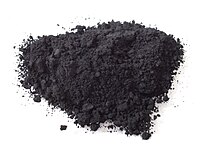
Photo from wikipedia
A detailed and global quantitative assessment of the distribution of pyrogenic carbon (PyC) in soils remains unaccounted due to the current lack of unbiased methods for its routine quantification in… Click to show full abstract
A detailed and global quantitative assessment of the distribution of pyrogenic carbon (PyC) in soils remains unaccounted due to the current lack of unbiased methods for its routine quantification in environmental samples. Conventional oxidation with potassium dichromate has been reported as a useful approach for the determination of recalcitrant C in soils. However, its inaccuracy due to the presence of residual non-polar but still non-PyC requires additional analysis by 13C solid-state nuclear magnetic resonance (NMR) spectroscopy, which is expensive and time consuming. The goal of this work is to examine the possibility of applying infrared (IR) spectroscopy as a potential alternative. Different soil type samples (paddy soil, Histic Humaquept, Leptosol and Cambisol) have been used. The soils were digested with potassium dichromate to determine the PyC content in environmental samples. Partial Least Squares (PLS) regression was used to build calibration models to predict PyC from IR spectra. A set of artificially produced samples rich in PyC was used as reference to observe in detail the IR bands derived from aromatic structures resistant to dichromate oxidation, representing black carbon. The results showed successful PLS forecasting of PyC in the different samples by using spectra in the 1800-400 cm-1 range. This lead to significant (P < 0.05) cross-validation coefficients for PyC, determined as the aryl C content of the oxidized residue. The Variable Importance for Projection (VIP) traces for the corresponding PLS regression models plotted in the whole IR range indicates the extent to which each IR band contributes to explain the aryl C and PyC contents. In fact, forecasting PyC in soils requires information from several IR regions. In addition to the expected IR bands corresponding to aryl C, other bands are informing about the patterns of oxygen-containing functional groups and the mineralogical composition characteristic of the soils with greater black carbon storage capacity. The VIP traces of the charred biomass samples confirm that aromatic bands (1620 and 1510 cm-1) are the most important in the prediction model for PyC-rich samples. These facts suggest that the mid-IR spectroscopy could be a potential tool to estimate the black carbon.
Journal Title: Journal of environmental management
Year Published: 2019
Link to full text (if available)
Share on Social Media: Sign Up to like & get
recommendations!